- Bernard Preston homepage
- Chickens
- Vegetable Garden Fence
Vegetable garden fence
Making a vegetable garden fence is not difficult but some tools are necessary.
Firstly, you'll need a sturdy pair of fencing pliers; and then a puller if you want to get the wires tight and make it look good. Neither are particularly expensive and you will get years of use out of them both; or, borrow from a friend if you really think this will be the only time you will doing this.
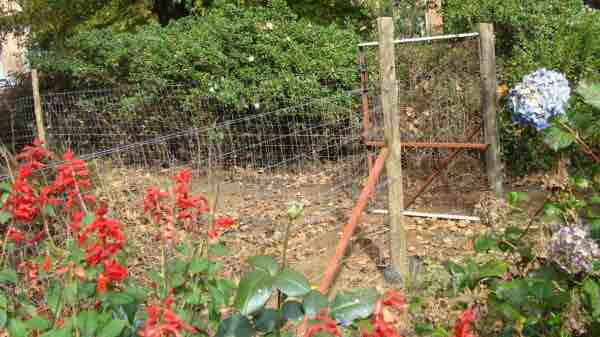
This page was last updated by Bernard Preston on 4th August, 2019.
A vegetable garden fence is a must, whether you are wanting to grow pole beans, or put up a surround to keep the hens out.
In fact, following these principles you could fence your whole property.
If you are wanting to keep your dogs in, then a concrete border takes a lot of beating; it is amazing how persistent they can be if there is a bitch on heat in the neighbourhood, causing you all sorts of headaches.
So what do you need? Firstly the makings of concrete are important; sand, stone and cement.
Then of course you need poles, either treated timber or steel; both will last for ever. 100mm diameter is sufficient, but 150 at the corners certainly would look nice.
A strainer at the ends is necessary, otherwise the pole will bow as soon as you put the wire under tension. These can be made very easily from any sort of scrap steel you have lying around, with a small foot so it does not turn in the ground.
Weld a tag onto the pole end, with a predrilled hole to fit onto a peg in the upright post.
First of course you must decide on how high you want the fence; it is best to sink the post into concrete at least 500mm deep.
I chose 1200mm high fence so the poles needed to be 1,7m long.
Vegetable garden fence
A vegetable garden fence really needs a puller to get the supporting wires tight. The Zulus call ours Satan; watch your fingers. Cables under tension can be damaging; I literally nearly lost my head once in a gliding incident.
Having said that, I have just completed our vegetable garden fence with no drama; just be careful as when using any tools. Take your time, and when you need a break, go for a cup of tea and a sweet pea. Over-tiredness is the cause of most injuries.
Choose the four corners for your vegetable garden fence, taking some measurements, and dig holes a spade wide, and 500mm deep.
Slot your pole into the hole, and fill it with weak concrete, using a level to make sure it is close to vertical; tamp the sand, stone and cement down with a stamper so that everything is compact and strong.
Fit the strainer, and concrete its foot into the ground too. Give it at least a day to dry, pouring on some water so the set is harder and firmer.
Set the posts in between about 10 m apart, or less if you want it stronger; droppers help to make it secure.
Now you are going to set three wires along the posts, under tension; first set the lowermost one, starting at any corner, about 20 mm above the ground; make marks on the pole. Use fencing nails at each, but do not wack them in just yet.
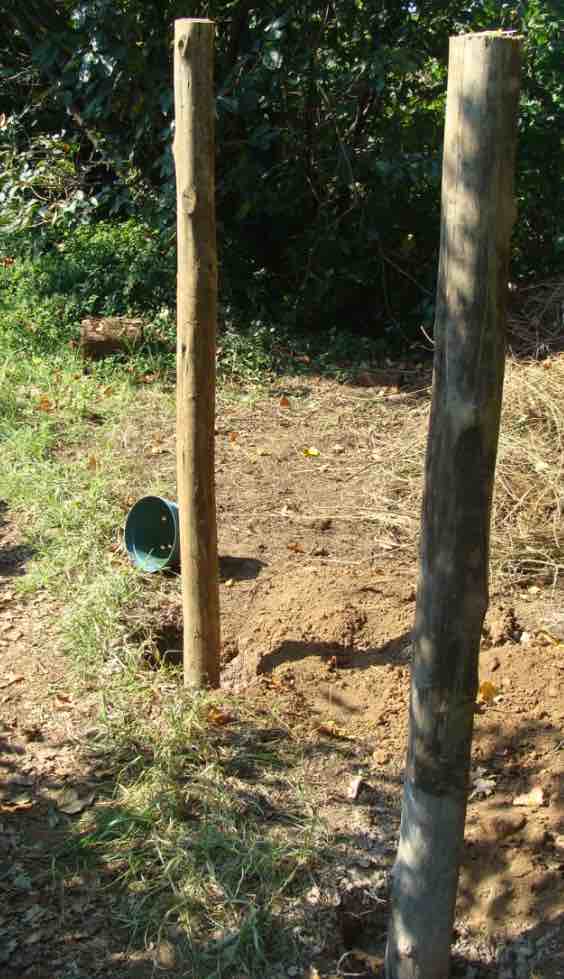
The fence puller is really an inexpensive gadget and worth every cent in the green home; you'll use it many times; pole beans and limas, for example, need to be supported.
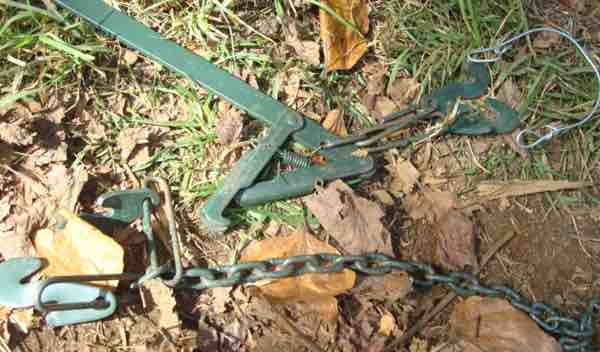
The fence puller comes in two parts; one with a large handle that hooks onto the post, and the other with the chain attached grabs onto the wire you are straining.
Notice the short piece of wire, with loops at each end that I've made; on the right hand side above; it goes around the corner fence post, just below the mark you've made.
Pull the wire you are straining around the post, on the mark, cutting it with an excess of about six inches. Tack two fencing nails, but don't wack them all the way in just yet.
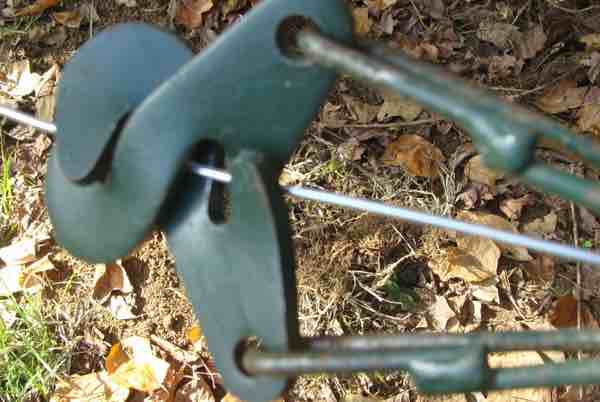
Attaching Satan to the wire is a Chinese puzzle; practise this several times before making a start.
Now practise hooking the puller correctly onto the chain as shown below.
Then, connecting its two hooks on that loop shown above, set just above or below the mark on the pole where you started nailing the wire, hook the puller onto the chain that is now attached to your cable.
Is it only clear as mud? Fiddle a bit and you'll get it right; it doesn't require a degree in higher learning; this is really a two man job, by the way.
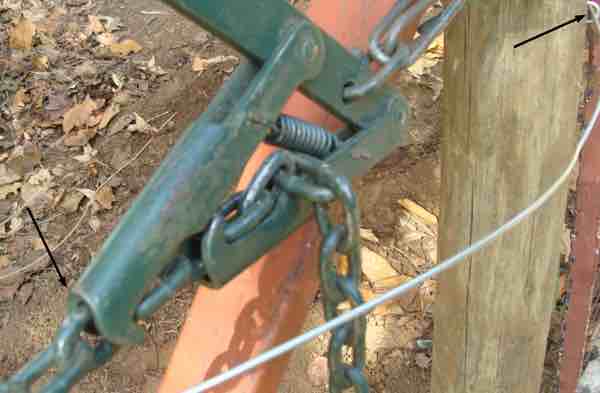
Then by pulling on that long handle you can tighten your cable, using the pliers to take in the slack; loosen the hook on the chain, and move it a couple links forwards; again tension the cable.
When you've got it as tight as you choose, not pulling the pole out the ground, use the fencing pliers to pull in the tension on the free end; now hammer those two fencing nails into the wood, and twist the loose end of the cable around the wire.
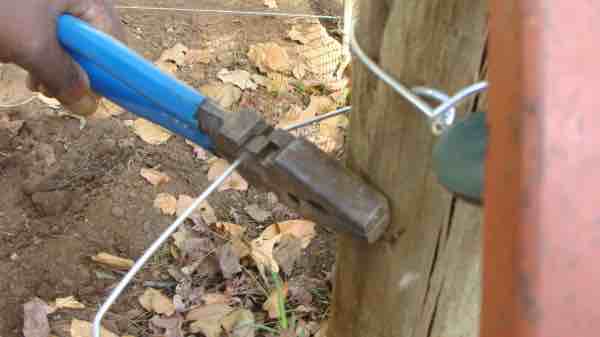
When you've got it as tight as you choose, not pulling the pole out the ground, use the fencing pliers to pull in the tension on the free end; now hammer those two fencing nails into the wood, and twist the loose end of the cable around the wire.

In my case, the fencing is 1200mm high; so the first wire is set say 20 mm above the ground, the next 600 higher, and the third at 1.2m; actually make is slightly lower so there's no danger that it might be above the top of the fence.
Once you've set your three fence wires, you are ready to hang the fencing on them. Starting at one corner post, the two of you can carefully unroll the fence and attach it to your fence wires with thin fencing wire; about every metre.
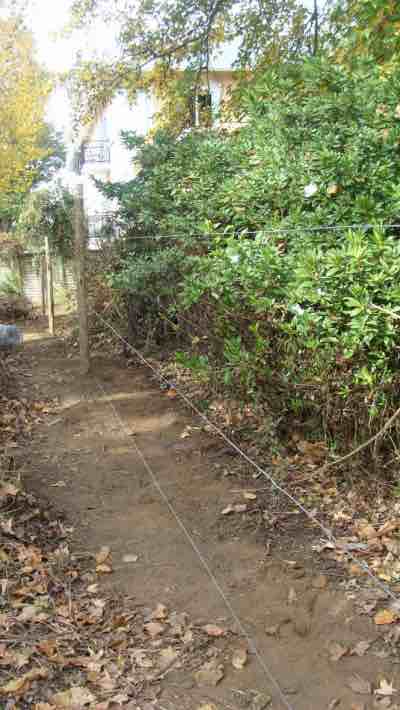
Once you've set your three fence wires, you are ready to hang the fencing on them. Starting at one corner post, the two of you can carefully unroll the fence and attach it to your fence wires with thin fencing wire; about every metre.
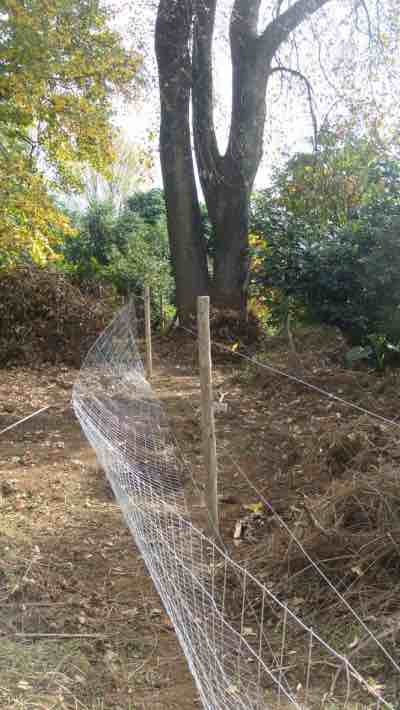
Your vegetable garden fence is almost complete, assuming you've already done your steel gate design work, or purchased a gate.
This vegetable garden fence is too low for growing pole or lima beans, but I'll plant granadillas along it; in America they call them passion fruit.
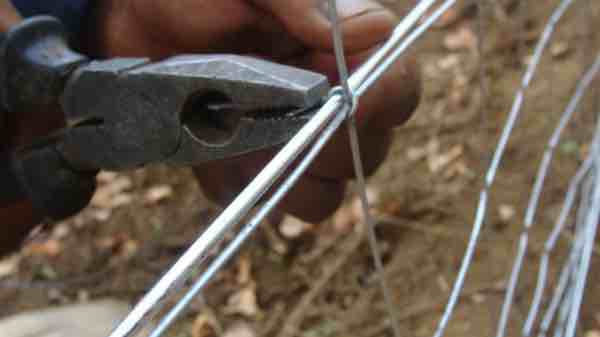
It took two of us a morning to complete this job, once the poles had been concreted in place, and left for a few days to set.
The puller did not take any fingers but there were a few scratches; a pair of gardening gloves is essential. There are two sections on either side of the gate; about fifty metres in total.
Newsletter
Our newsletter is entitled "create a cyan zone" at your home, preserving both yourself and Mother Earth for future generations; and the family too, of course. We promise not to spam you with daily emails promoting various products. You may get an occasional nudge to buy one of my books.
Here are the back issues.
- Lifestyle and ideal body weight
- What are ultra-processed foods?
- Investing in long-term health
- Diseases from plastic exposure
- Intensive lifestyle management for obesity has limited value
- A world largely devoid of Parkinson's Disease
- The impact of friendly bacteria in the tum on the prevention of cancer
- There's a hole in the bucket
- Everyone is talking about weight loss drugs
- Pull the sweet tooth
- If you suffer from heartburn plant a susu
- Refined maize meal and stunting
- Should agriculture and industry get priority for water and electricity?
- Nature is calling
- Mill your own flour
- Bake your own sourdough bread
- Microplastics from our water
- Alternative types of water storage
- Wear your clothes out
- Comfort foods
- Create a bee-friendly environment
- Go to bed slightly hungry
- Keep bees
- Blue zone folk are religious
- Reduce plastic waste
- Family is important
- What can go in compost?
- Grow broad beans for longevity
- Harvest and store sunshine
- Blue zone exercise
- Harvest and store your rainwater
- Create a cyan zone at your home
You can use these basic principles to put up a vegetable garden fence to keep dogs and hens out of your lettuces and beans; in fact in this instance we are creating a chicken run of about a thousand square metres for our free range eggs; the birds are the most spoiled in the whole land, my wife says.
They feast on kale, spinach and wrigglies from the worm farm; and will demolish the broccoli seedlings if you are without a vegetable garden fence.
Her allegation is probably true but our cage free eggs are also the best in the land. In particular they are rich in omega 3 fatty acids, essential for normal brain function; and choline, a strong anti-inflammatory vitamin.
It is all quite hard work but it is the reason we could cancel our gym contracts and take virtually no medicine; right now the boss is on antibiotics for a nasty bronchitis, the first drugs either of us have had in a couple years.
A daily dose of kefir is a wonderful probiotic; replenishing the friendly bugs in the body.
If you read just one book a month, you'll probably fall short of a thousand in your whole life; and most likely nearer 500. Enjoying a good novel is like having a private conversation with the author.
If you are enjoying Bernard-Preston.com, then perhaps I can invite you to a journey through the polders of Holland. That's how you can support this site, and enrich your own life with some easy bedside reading and stepping up to better health.
My books are available from Amazon on Kindle.
Garden trellis
I originally put up a vegetable garden fence or two for growing climbers like pole beans. It was fine for a few seasons but then the lack of crop rotation took its toll.
Now I prefer a vegetable garden trellis for the beans.
Vegetable garden fences are very necessary if you are going to make a start with what's today being called urban agriculture; growing your own food and perhaps even making a small business out of the surplus.
The only produce that we sell is our surplus honey from ten hives; if I had 100 colonies, I could retire! It's a very profitable little business.
Did you find this page interesting? How about forwarding it to a friendly book or food junkie? Better still, a social media tick would help.
- Bernard Preston homepage
- Chickens
- Vegetable Garden Fence
Address:
56 Groenekloof Rd,
Hilton, KZN
South Africa
Website:
https://www.bernard-preston.com